Angelo Barovier - The bridal or wedding cup

Wedding cup of Angelo Barovier Angelo Barovier was the son of Iacobo Barovier, himself a Master glassmaker in Murano.
But Angelo decided to set up his own glassworks and this decision is known to us from the date of the operating licence granted to him in 1422.
Angelo Barovier's current fame is linked to the famous "Coppa Barovier", the bridal cup still known as the Barovier wedding cup but also to the fact that he is said to be the inventor of the Cristalo as well as the Lattimo.
Barovier's wedding cup dates from the middle of the 15th century. It is made of blue glass enamelled with polychrome enamel and depicts the recurring themes of the period concerning marriage and its virtues: love, modesty and eternity.
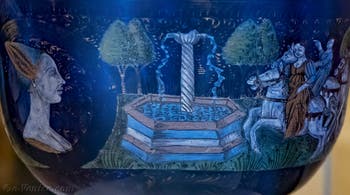
Wedding cup by Angelo Barovier This Barovier cup is one of the earliest examples of Renaissance enamelled glass.
Enamel paints were used to create the decorations on this wedding goblet by Angelo Barovier.
However, experts do not believe that Barovier himself painted the motifs on his bridal cup.
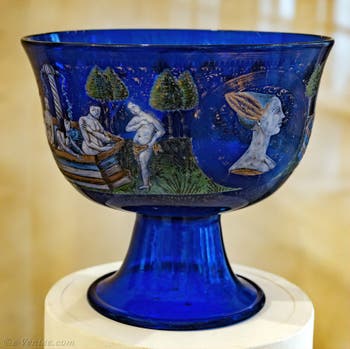
Wedding cup by Angelo Barovier In fact, from the inventory documents of the products stored in the glassmakers' workshops at the time, it is clear that the decoration of enamelled and gilded glass was entrusted to other craftsmen, and the decoration of the goblet also shows their degree of expertise, verging on illumination for the finesse of certain small details.
We also know that the two portraits on the cup were those of the bride and groom.
We can therefore assume that not only decorating the cup, but also depicting faithful portraits, could only have been entrusted to a painter.
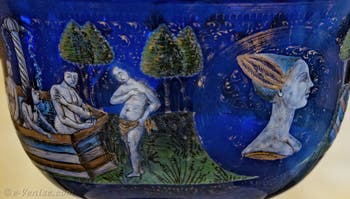
Wedding cup by Angelo Barovier Perhaps Angelo Barovier had painting skills but we have no clues or evidence to prove this.
What's more, the already delicate manufacture of the glass itself must have taken up enough of Angelo Barovier's time that he couldn't also decorate his blown works.
The wedding goblet is a simple goblet made of azure-blue glass depicting scenes of courtly love: the maidens ride on horseback to the fountain of youth (or love) and bathe in the fountain of youth.
The Bath in the Fountain of Youth
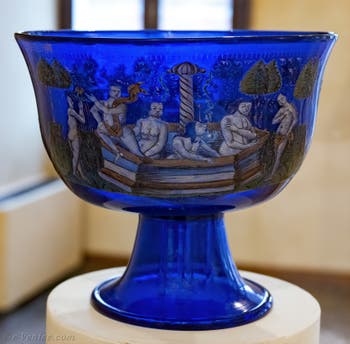
Wedding cup by Angelo Barovier Bathing in the fountain of youth or love is a recurrent theme in fifteenth-century painting, so it is not unusual to find it also present on this wedding cup by Barovier.
The Fountain of Youth is a symbol of immortality in biblical and classical mythology.
The source of the Fountain of Youth is in fact in the Garden of Eden.
As well as granting immortality, the water from the fountain heals and... an important element for our newlyweds : bathing in it makes you younger!
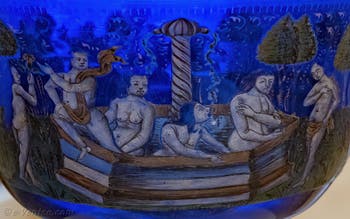
Wedding cup by Angelo Barovier The beauty and finesse of the details are quite remarkable when you consider that this is enamelled glass and what technical constraints this represented for the time, both for the painter and for the Master Glassmaker.
The scene is particularly lively, the figures are not at all static and are bathed in a soft light.
The artist who created this work perfectly integrated the notions of transparency of his blue enamelled glass support while using this background colour to better highlight his figures.
Angelo Barovier - The Nuptial Cup and the Cavalcade of the Young Girls to the Fountain of Youth
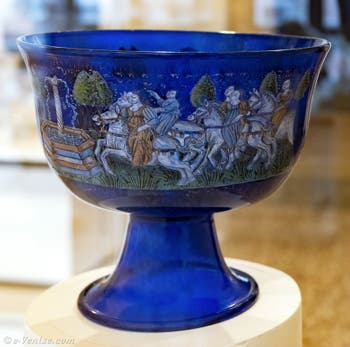
Wedding cup by Angelo Barovier The cavalcade of young girls towards the fountain of youth is also a well-known and recurring theme from this period.
Here too, the artist's talents are evident, the quality of the drapery, the dynamism of the attitudes, the horses in full race...
This work is also to be commended for the artist's ability to take advantage not only of the transparency and colour of the cut but also of the shape of the cut.
It seems obvious at first glance, but not only is the bowl round, it is also flared.
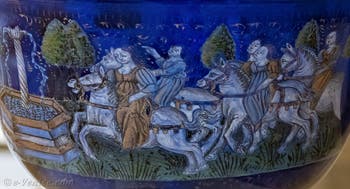
Wedding cup by Angelo Barovier These different elements also forced the artist to distort some of his drawings so that the whole could remain coherent.
It's also worth noting that although the characters are "posed" on a transparent background, almost optically on empty space, the artist who created the work has nevertheless managed to give an impression of depth of field to the whole by creating several successive planes.
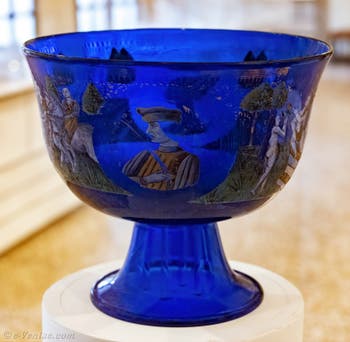
Wedding cup by Angelo Barovier Angelo Barovier's bridal cup also features a portrait of the bride-to-be and her fiancé.
Angelo Barovier and the Cristalo
Angelo Barovier is also credited with the discovery of "Cristalo" or Cristallo.A reference to this famous crystal by Angelo Barovier can be found in a document dated 1453, which has in its list of objects a crystallo salt shaker with a market value of four silver grossi, the currency in use at the time in Venice.

Wedding cup by Angelo Barovier
Angelo Barovier had succeeded in developing this crystal-like glass by carrying out a series of complex operations designed to rid the glass of impurities and give it the clarity so sought after at the time.
The government of the Republic of Venice rewarded Barovier for this discovery by granting him a special licence giving him the right to produce his new cristalo during the compulsory annual closure of the furnaces, i.e. from mid-August to mid-January.

Wedding cup by Angelo Barovier An award, no doubt, that Barovier greatly appreciates in comparison with its glassmaking competitors.
The new crystallo or cristalo developed by Angelo Barovier attracted immediate attention. Duke Francesco Sforza, Duke of Milan, invited Barovier to manufacture his crystal in his duchy.
Angelo Barovier did indeed go with one of his sons, but they were back in Murano by 28 December 1455.
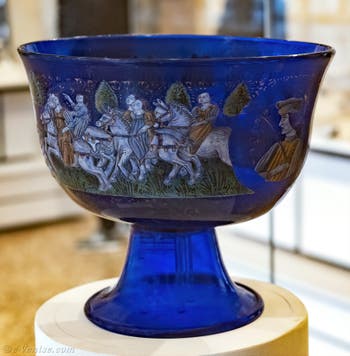
Wedding cup by Angelo Barovier Cosimo de Medici invited him to come to Florence in 1459 but Angelo Barovier died the following year, in 1460 and was therefore unable to accept the invitation.
Current experts believe, however, that the cristalo technique would have been older and that Angelo Barovier would therefore not have been the first to discover or use it.
The "Lattimo" Angelo Barovier's other invention
On the other hand, lattimo, an opaque white glass, was indeed invented by Angelo Barovier around 1450.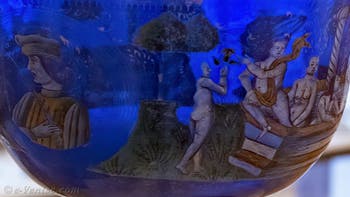
Wedding cup by Angelo Barovier Its existence is moreover recounted in a document drawn up in Murano in 1457, a document relating to a patent granted to Jacopo d'Angelo under the name porcellano because similar to Chinese porcelain in its appearance despite being made of glass.
Lattimo was also a glass that, like all glass, could be blown, which increased its possibilities in terms of shape.
Back to Top of Page

